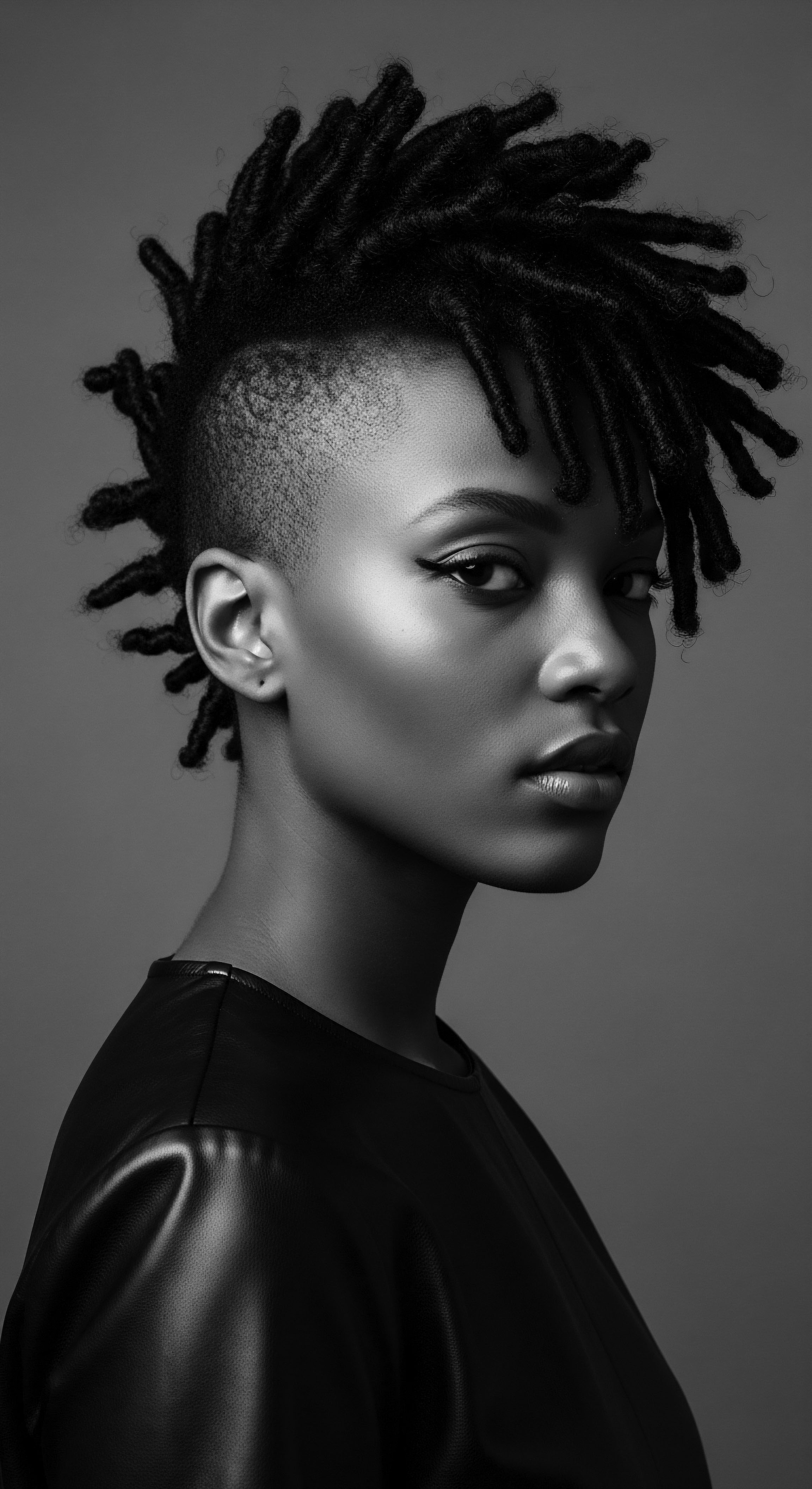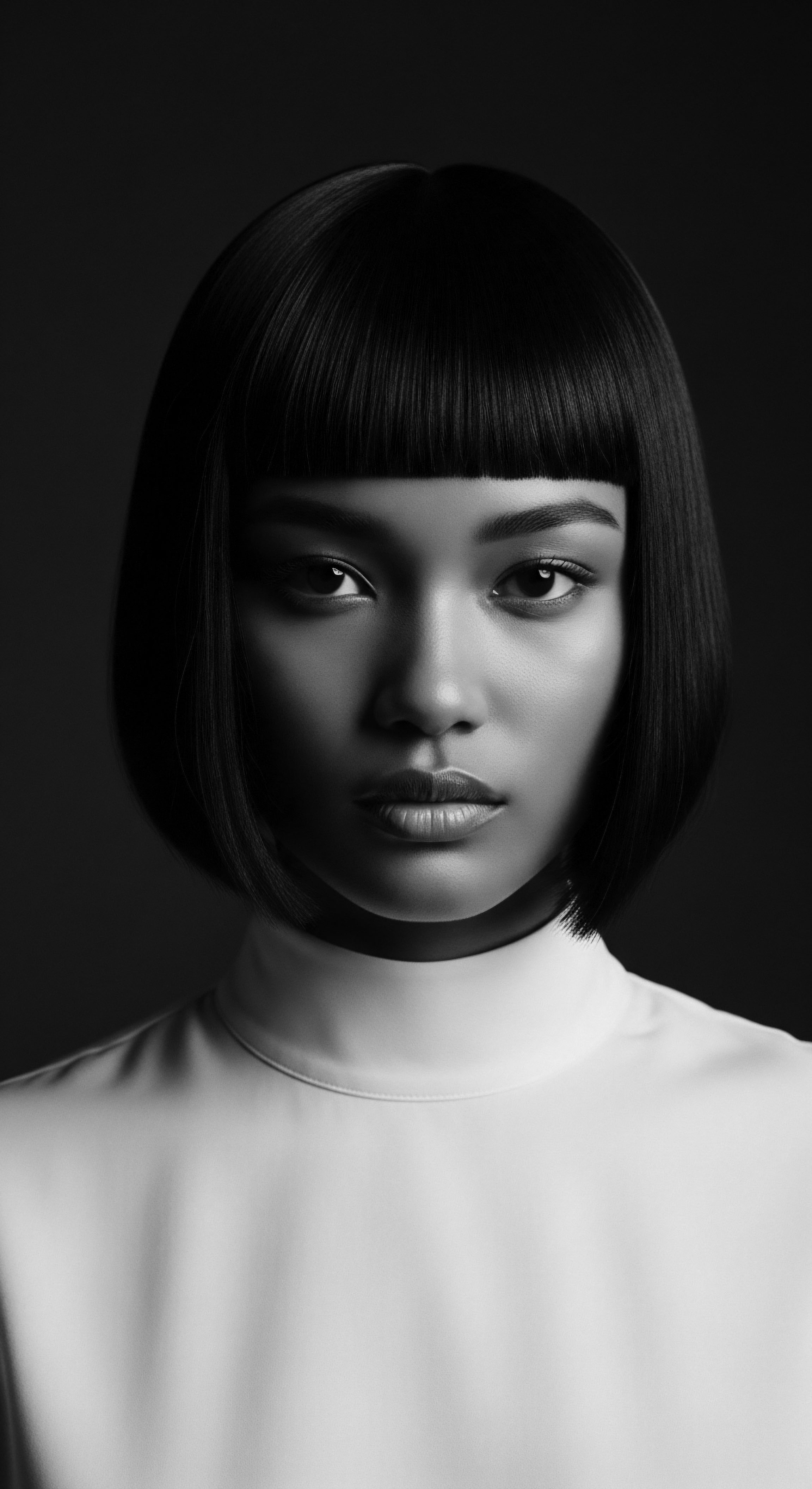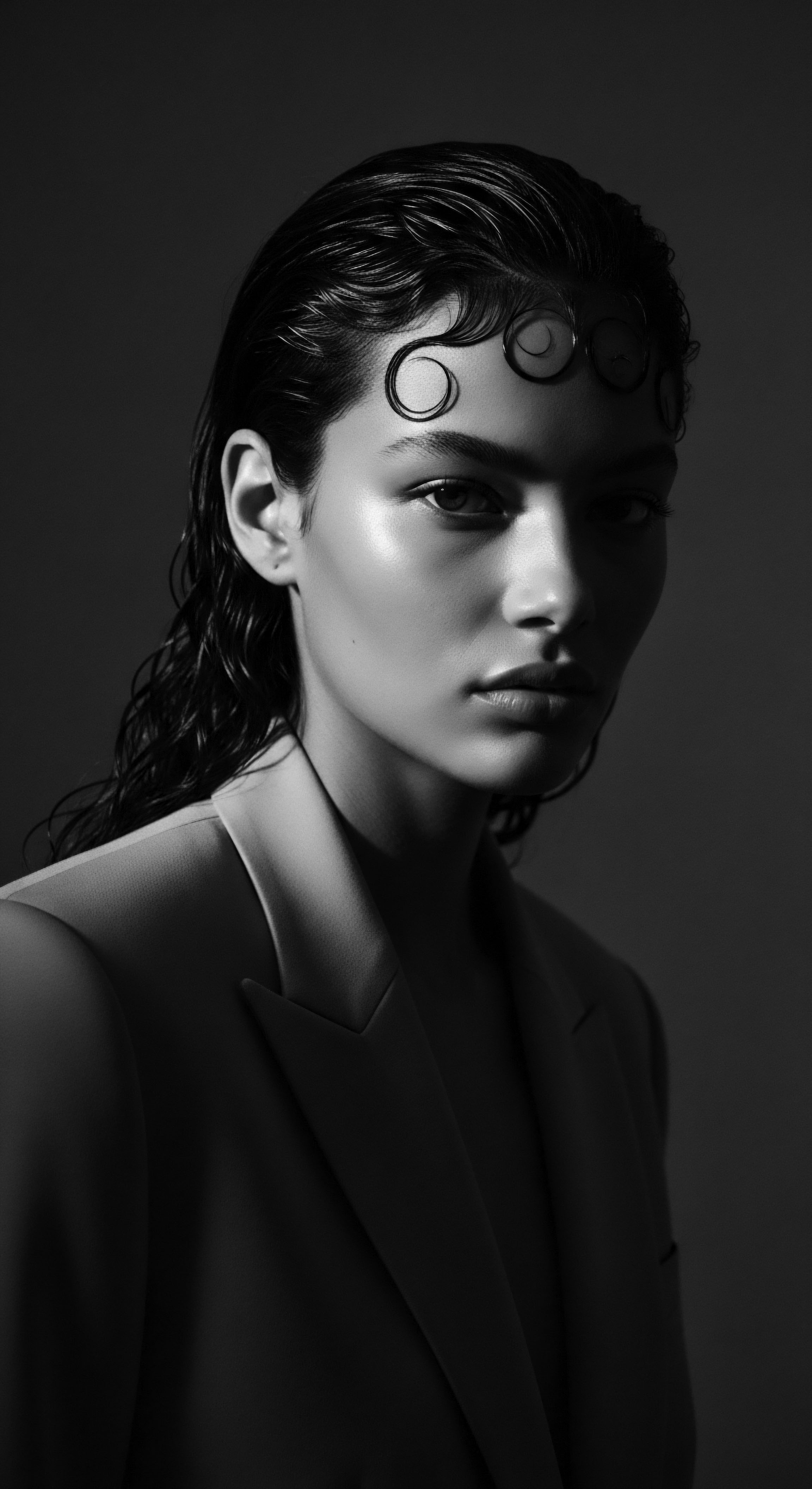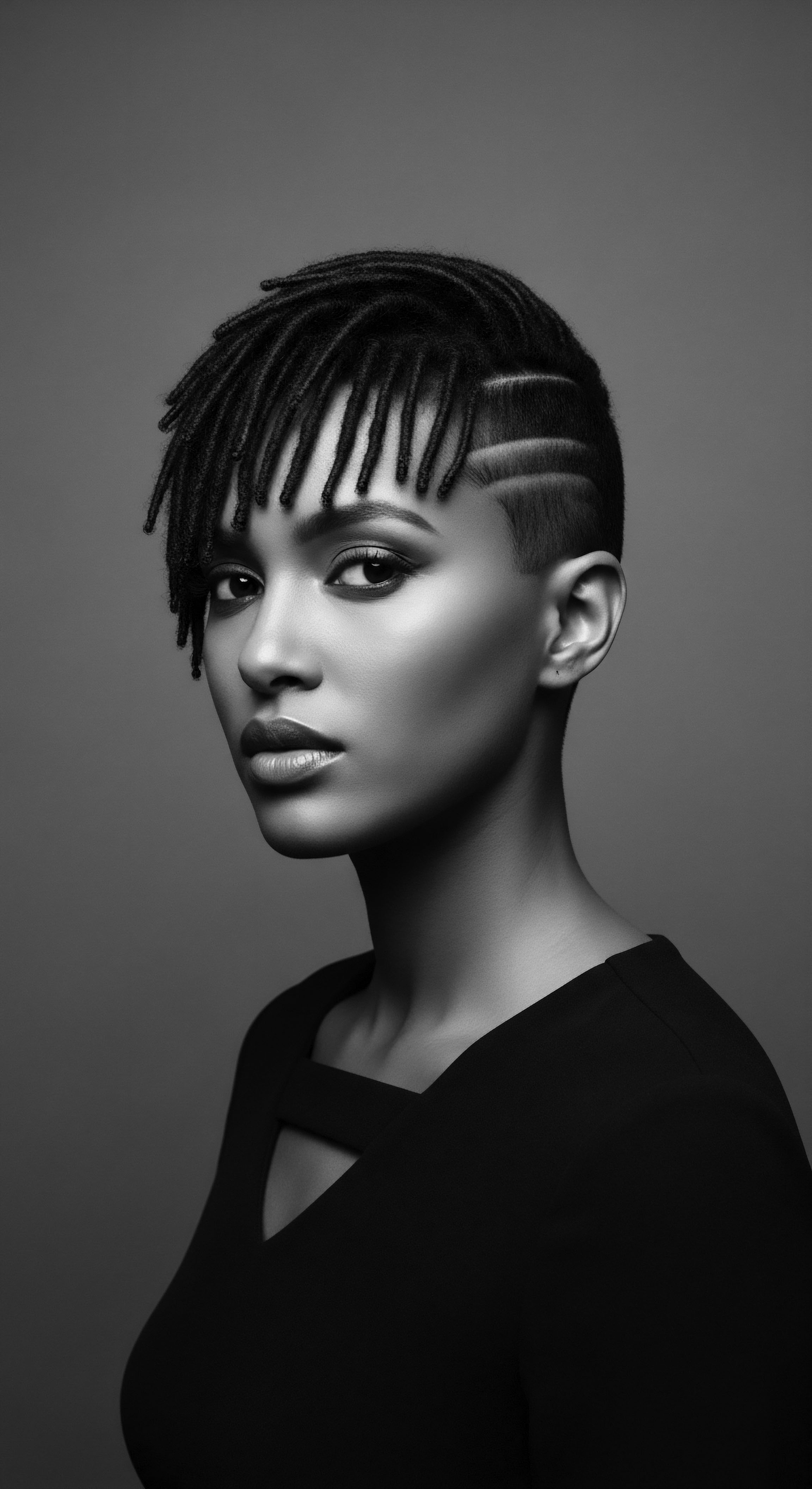
Roots
To journey into the ancestral care of textured hair, one must first recognize the profound connection woven between strand and spirit, between scalp and soil. For millennia, hair has been far more than mere biological filament; it has stood as a living archive, a visible testament to identity, status, and community across African and diasporic cultures. When we seek to understand how ancient tools helped style textured hair, we are not simply cataloging implements.
We are, instead, exploring the very origins of beauty practices deeply embedded in heritage, understanding how our forebears engaged with the unique characteristics of coily, kinky, and wavy hair with ingenuity and reverence. This exploration begins with the fundamental understanding of textured hair itself, seen through the lens of ancient wisdom validated by contemporary science.

Hair Anatomy and Ancient Understanding
The distinct shape and behavior of textured hair, with its elliptical follicle and varying curl patterns, present specific considerations for styling and maintenance. From the tightly coiled strands that defy gravity to the gentle waves that flow with graceful ease, each hair type possesses a unique architecture. While modern microscopy reveals the precise molecular arrangement of disulfide bonds and keratin structures, our ancestors possessed an intuitive, observational understanding. They knew the propensity of textured hair to dryness, its tendency to tangle, and its remarkable ability to hold intricate styles.
This intimate knowledge guided their selection and crafting of tools. They recognized that coarse, often dry, hair demanded specific care, favoring wide-toothed implements that would not snag or damage its delicate structure. They understood that coils, when properly hydrated and manipulated, could be sculpted into forms that symbolized power, beauty, or lineage.
Ancient tools for textured hair are not simply artifacts; they are echoes of ancestral hands, a testament to the enduring human desire for self-expression through hair.

Earliest Instruments of Adornment
The earliest tools for hair styling were likely extensions of the human hand, perhaps sharpened stones, natural fibers, or smoothed wood. Yet, archaeological discoveries have unearthed highly specialized instruments dating back thousands of years, particularly from ancient African civilizations. These early combs and picks, crafted from materials such as wood, bone, and ivory, speak volumes about the dedication to hair care and styling.
The very presence of these implements in ancient burials, notably in Kush and Kemet (modern-day Sudan and Egypt), indicates their profound value and sacred status. These were not disposable objects; they were often adorned with carvings of animals or symbolic motifs, reflecting a deep respect for nature and the spiritual world.
- Kemetian Combs ❉ Dating back as far as 7,000 years, these long-toothed combs, often decorated with birds, bull horns, or hippopotamus figures, were essential for detangling and styling dense, textured hair.
- Hairpins ❉ Simple pins of bone and ivory were in use in Egypt by approximately 4000 BCE, used to secure long hair in upswept styles.
- Natural Elements ❉ Hands, fingers, and perhaps braided plant fibers were fundamental in initiating intricate patterns, emphasizing the organic connection to the environment.

The Lexicon of Ancient Hair
Though we do not possess a complete dictionary of ancient hair terminology, the very existence of these tools, and the elaborate hairstyles depicted in ancient art, points to a rich vocabulary surrounding hair and its care. Hairstyles in pre-colonial African societies served as a visual language, communicating social status, age, tribal identity, marital status, and even spiritual beliefs. The tools used to create these styles became intrinsically linked to this visual lexicon. A certain comb might be associated with a specific clan’s traditional patterns, or a particular adornment might signify a woman’s readiness for marriage.
The enduring legacy of terms like “cornrows” (often linked to agricultural patterns or “cane rows” in the diaspora) and “Bantu knots” (Zulu knots), speaks to a continuity of practice and naming that transcends centuries. These ancient tools were not merely functional; they were vessels of cultural meaning, passed down through generations, their designs often mirroring the complex social structures and deep spiritual understandings of their communities.

Ritual
The daily engagement with textured hair in ancient times transcended mere grooming; it blossomed into a series of deeply ingrained rituals, ceremonies that celebrated identity, connection, and ancestral wisdom. Ancient tools were not simply implements of function; they were extensions of this ritual, mediating the physical act of styling with its profound social and spiritual meanings. The very act of combing, braiding, or adorning hair became a shared experience, a quiet moment of care, or a vibrant communal gathering.

What Did Ancient Tools Shape in Daily Practice?
Consider the rhythm of life in ancient African communities. The sun dictated the day, and communal activities often marked its passage. Hair care was no different. Wide-toothed combs, fashioned from wood, bone, or ivory, were essential for detangling the dense, coily strands that could otherwise matte easily.
These early combs, some resembling the modern afro pick, were designed to gently separate hair without causing breakage, a testament to an understanding of textured hair’s delicate nature. The meticulous parting of hair for intricate braiding or twisting required precise instruments, often small, pointed tools or even the skilled use of fingers and thumbs.
Beyond simple combs, archaeological records and ethnographic studies reveal a spectrum of tools used for specific styling techniques. For instance, in ancient Egypt, while elaborate wigs were common for the elite, actual hair was also styled using tools like bronze curling tongs, heated over fire to achieve desired shapes. This suggests an early understanding of thermal manipulation, albeit with rudimentary means, to alter hair’s natural texture for specific ceremonial or aesthetic purposes. Hairpins, often crafted from precious materials like gold, silver, bone, or wood, served to secure elaborate updos or plaits, providing structural integrity to complex styles.
The hands that wielded ancient tools were guided by generations of inherited wisdom, turning hair styling into a dialogue between past and present.

Communal Care and Sacred Space
The styling of textured hair was frequently a communal affair, particularly for women. It was a time for storytelling, for sharing wisdom, for strengthening bonds within the family and wider community. Tools like combs and picks were passed between hands, becoming silent witnesses to conversations, laughter, and the transmission of skills from elder to youth. This shared experience solidified social cohesion.
A mother might detangle her child’s hair with a hand-carved comb, imparting not just physical care, but also stories of their lineage and the cultural significance of their hair. Such practices were not merely functional; they transformed grooming into a sacred space, a place where heritage was actively lived and sustained.
Protective styles, such as braids and twists, were not solely for aesthetic appeal; they offered practical benefits, shielding hair from environmental elements and minimizing breakage. The tools that facilitated these styles – the parting sticks, the needles for extensions, the smooth stones for pressing – were therefore central to hair health and longevity within ancestral contexts. The continuity of these traditional techniques, from the intricate patterns of West African braiding (e.g. Fulani braids) to the coiled elegance of Nubian twists, speaks to the enduring efficacy and cultural resonance of the tools and methods employed.
| Tool Type Wide-Tooth Combs / Picks |
| Traditional Materials Wood, Bone, Ivory, Animal Horn |
| Primary Styling Function Detangling, lifting, creating volume, parting sections. Essential for managing coily textures. |
| Tool Type Hairpins / Adornments |
| Traditional Materials Bone, Ivory, Gold, Silver, Wood, Beads, Shells |
| Primary Styling Function Securing elaborate styles, holding braids, adding ceremonial or status-related decoration. |
| Tool Type Styling Sticks / Needles |
| Traditional Materials Smoothed Wood, Bone, Metal |
| Primary Styling Function Creating precise parts, assisting with intricate braiding, lacing extensions, or forming loops. |
| Tool Type Heated Tongs / Irons |
| Traditional Materials Bronze, Iron (Early forms) |
| Primary Styling Function Curling or shaping hair/wigs; applied carefully to achieve specific textures for ceremonial display. |
| Tool Type These tools, often crafted with symbolic motifs, were central to both practical hair care and the expression of identity across ancient African communities. |

Relay
The story of ancient tools in styling textured hair extends beyond their immediate utility; it speaks to the transmission of knowledge, the adaptation of practices, and the profound resilience of cultural identity. These tools are physical manifestations of an ancestral intellectual heritage, embodying centuries of observation, experimentation, and artistic expression. The very act of creating and using these implements demonstrates an advanced understanding of material science, hair biology, and social semiotics within pre-colonial African societies.

How Did Tool Ingenuity Mirror Ancestral Hair Science?
The ingenuity behind ancient hair tools lies in their design, which was often perfectly calibrated to the unique physical properties of textured hair. Consider the design of the wide-toothed comb or pick, a precursor to the modern afro pick. The significant spacing between its teeth prevented snagging and breakage, issues that frequently plague finer combs when used on dense, coily hair.
This design was not accidental; it was a direct response to the inherent characteristics of hair, showcasing an intuitive, empirical understanding of how best to manipulate it. The development of such tools suggests a sophisticated process of trial and error, where communal knowledge was refined over generations.
Indeed, some archaeological evidence suggests that hair products were also used in conjunction with these tools. In ancient Egypt, mummies have revealed traces of fat-based products on their hair, used to mold and hold styles in place, often in intricate curls and braids. This application of natural emollients, perhaps in combination with heated bronze tongs, allowed for precise shaping and long-lasting styles.
The ability to create these formulations, along with the tools for application and styling, represents a significant, albeit undocumented, ancestral hair science. It reveals a deep awareness of hair’s needs for moisture and hold, anticipating modern hair product chemistry.

What Role Did Hair Tools Play in Cultural Survival During Displacement?
The legacy of these ancient tools and styling practices took on an especially profound significance during periods of forced displacement, particularly the Transatlantic slave trade. Stripped of most material possessions and cultural markers, enslaved Africans found ways to carry their heritage within their bodies, and their hair became a powerful canvas for resistance and memory.
A specific historical example of this resilience lies in the use of cornrows. During enslavement, women on plantations would use intricate cornrow patterns to create maps, often braiding rice seeds into their hair as a means of survival and cultural preservation. This practice, documented in historical accounts, turned hair into a living, portable archive of ancestral knowledge and a tool for potential escape. The skills required to execute such complex styles were passed down, often covertly, from generation to generation, ensuring the continuity of a heritage threatened with erasure.
Though traditional combs might have been scarce or confiscated, the memory of their function and the ingenuity of adapting available materials—like sharpened sticks or bone fragments—to recreate their effect persisted. The very act of styling hair became an act of defiance, a quiet assertion of identity, and a communal bonding ritual, reinforcing a collective memory of home and freedom.
The enduring power of hair tools to convey meaning extends into more recent history. The rise of the afro pick in the 1960s and 1970s in the Americas transformed a functional object into a potent symbol of Black pride and identity during the Civil Rights movement. The addition of the “black fist” emblem, popularized in 1972, solidified its status as a political emblem and a statement of collective identity. This evolution of the hair tool, from ancient ceremonial object to a symbol of contemporary liberation, underscores its unwavering connection to Black and mixed-race heritage across centuries.
Graham Connah’s work, particularly in “African Civilizations ❉ An Archaeological Perspective,” illuminates the broader context of material culture in shaping African societies. While not exclusively focused on hair tools, his archaeological insights into social complexity and material evidence provide a framework for understanding how such implements were integral to the social fabric and cultural practices of ancient African communities. The continuous archaeological recovery of various hair implements across different periods and regions of Africa underscores their enduring significance in the development of human expression and social structures.
The understanding of hair structure, and thus the efficacy of tools, has been subtly validated by modern science. The observation that tightly coiled hair is inherently drier and more prone to tangling, due to its shape and fewer cuticle layers, explains why wide-toothed tools were essential for gentle detangling in ancient times. The ancestral wisdom of using natural oils and butters for moisture and hold, often applied with specific tools, aligns with contemporary dermatological recommendations for textured hair care. This scientific resonance between ancient practices and modern understanding speaks to the deep, experiential knowledge cultivated by our ancestors.
- Oral Histories ❉ Many traditional hair care methods, including tool usage, were transmitted through oral traditions and hands-on teaching within families.
- Community Gatherings ❉ Hair styling sessions served as vital communal spaces for sharing cultural knowledge, news, and strengthening social ties.
- Adaptation in Adversity ❉ During enslavement, the cultural memory of tools and techniques persisted, leading to innovation with limited resources.

Reflection
The journey through ancient tools and their profound impact on textured hair styling reveals a continuous, shimmering thread of heritage that binds us to our past. Each comb, every pin, the very methods of styling that stretched across millennia, carry the whispers of ancestral hands and the quiet power of traditions preserved against formidable currents. Roothea’s ‘Soul of a Strand’ ethos finds its living archive within these historical echoes, reminding us that textured hair is not merely a biological inheritance, but a living legacy, a testament to resilience, creativity, and identity.
The wisdom held within these practices and tools is not static; it is a dynamic force, continually shaping our understanding of care, beauty, and communal belonging. To recognize the enduring presence of ancient tools in our contemporary hair practices is to honor the ingenuity of those who came before us, and to walk forward with a deeper sense of reverence for the strands that crown us.

References
- Byrd, Ayana, and Tharps, Lori. Hair Story ❉ Untangling the Roots of Black Hair in America. St. Martin’s Griffin, 2001.
- Connah, Graham. African Civilizations ❉ An Archaeological Perspective. 3rd ed. Cambridge University Press, 2016.
- Fletcher, J. Ancient Egyptian Hair ❉ a study in style, form and function. Unpublished PhD thesis, University of Manchester, 1995.
- O’Neal, Gwendolyn E. Hair in African Society ❉ An African-American History. Praeger, 2012.
- Preston, George Nelson. Hair in African Art and Culture ❉ An Illustrated History. The Metropolitan Museum of Art, 1999.
- Sherrow, Victoria. Encyclopedia of Hair ❉ A Cultural History. Greenwood Press, 2006.
- Synnott, Anthony. The Anthropology of Hair. Berg Publishers, 2007.
- Tassie, G.J. “Hair-Offerings ❉ An Enigmatic Egyptian Custom.” Papers from the Institute of Archaeology, vol. 7, 1996, pp. 59-67.
